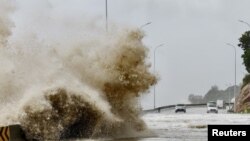ພາກພື້ນເອເຊຍຕາເວັນອອອກສຽງໃຕ້ ແມ່ນນຶ່ງໃນຫຼາຍພາກພື້ນທີ່ມີແນວໂນມຈະຖືກກະທົບໂດຍໄພພິບັດທຳມະຊາດຫຼາຍທີ່ສຸດ, ແຕ່ການວິເຄາະໃໝ່ທີ່ຖືກເປີດເຜີຍໃນວັນພະຫັດວານນີ້ສະແດງໃຫ້ເຫັນວ່າ ປະຊາຊົນຂອງເຂົາເຈົ້າຍັງຮູ້ສຶກວ່າມີຄວາມພ້ອມທີ່ສຸດທີ່ຈະຮັບມືກັບມັນ.
ມັນເບິ່ງຄືວ່າມີເຫດຜົນທີ່ວ່າປະເທດຕ່າງໆຢູ່ໃນ ແລະ ອ້ອມວົງແຫວນໄຟຂອງມະຫາສະໝຸດປາຊີຟິກ, ທີ່ມີຄວາມສ່ຽງຕໍ່ແຜ່ນດິນໄຫວ, ພາຍຸໄຕ້ຝຸ່ນ, ລະດັບນ້ຳຂຶ້ນທີ່ບໍ່ປົກກະຕິຍ້ອນພາຍຸ ແລະອັນຕະລາຍອື່ນໆ, ແມ່ນມີຄວາມພ້ອມທີ່ສຸດ, ແຕ່ການສຳຫຼວດໂດຍອົງການ Gallup ສຳລັບມູນນິທິ Lloyd’s Register ໄດ້ສະແດງໃຫ້ເຫັນວ່າ ມັນບໍ່ເປັນເຊັ່ນນັ້ນຕະຫຼອດໄປໃນພາກພື້ນອື່ນ.
ທ່ານ ເບເນດິກ ໄວເກີສ໌, ທີ່ປຶກສາການຄົ້ນຄວ້າຈາກອົງການ Gallup, ໄດ້ກ່າວຕໍ່ອົງການຂ່າວ AP ວ່າ “ການມີຄວາມສ່ຽງຢ່າງເປັນປະຈຳຕໍ່ອັນຕະລາຍ ບໍ່ພຽງແຕ່ເປັນປັດໃຈທີ່ພິຈາລະນາວ່າຄົນມີຄວາມຮູ້ສຶກກຽມພ້ອມແນວໃດ.”
ລາຍງານໄດ້ພົບວ່າສະມາຄົມປະຊາຊາດແຫ່ງເອເຊຍຕາເວັນອອກສຽງໃຕ້ ຫຼື ອາຊຽນ ໄດ້ມີບົດບາດທີ່ສຳຄັນໃນການຫຼຸດຜ່ອນຄວາມສ່ຽງຈາກໄພພິບັດ, ແລະ ທ່ານ ໄວເກີສ໌ ໄດ້ກ່າວວ່າວິທີການທີ່ກວ້າງຂວາງຂອງພາກພື້ນດັ່ງກ່າວລວມມີລະບົບການເຕືອນລ່ວງໜ້າທີ່ມີຢ່າງກວ້າງຂວາງ ແລະ ມີປະສິດທິພາບ, ວິທີການສົ່ງເສີມການປ້ອງກັນໃນຊຸມຊົນ ແລະ ການຮ່ວມມືໃນພາກພື້ນ, ແລະ ການເຂົ້າຫາການເງິນໄພພິບັດທີ່ດີ.
ທ່ານໄດ້ກ່າວວ່າ “ຄວາມສຳເລັດຂອງພາກພື້ນເອເຊຍຕາເວັນອອກສຽງໃຕ້ ກ່ຽວກັບ ການກຽມພ້ອມຮັບມືກັບໄພພິບັດ ສາມາດເຊື່ອມໂຍງໃສ່ກັບຄວາມສ່ຽງຕໍ່ໄພພິບັດທີ່ສູງຂອງເຂົາເຈົ້າ, ຄວາມສາມາດໃນການກັບຄືນສູ່ສະພາບເດີມໃນລະດັບທີ່ຂ້ອນຂ້າງສູງຂອງເຂົາເຈົ້າ ຈາກປະຊາຊົນສ່ວນບຸກຄົນຫາສັງຄົມໂດຍລວມ, ແລະ ວິທີການຂອງພາກພື້ນ ແລະ ການລົງທຶນເຂົ້າໃນການຈັດການຄວາມສ່ຽງດ້ານໄພພິບັດຢ່າງກວ້າງຂວາງກວ່າເກົ່າ.”
40 ເປີເຊັນຂອງປະຊາຊົນທີ່ຖືກສຳຫຼວດໃນເອເຊຍຕາເວັນອອກສຽງໃຕ້ກ່າວວ່າເຂົາເຈົ້າໄດ້ປະສົບກັບໄພພິບັດທຳມະຊາດໃນຫ້າປີທີ່ຜ່ານມາ, ໃນຂະນະທີ່ຕົວເລກທີ່ຄ້າຍຄືກັນ 36 ເປີເຊັນໃນເອເຊຍໃຕ້ໄດ້ກ່າວຄືກັນ. ແຕ່ປະຊາຊົນໃນພາກພື້ນເອເຊຍຕາເວັນອອກສຽງໃຕ້ 67 ເປີເຊັນກ່າວວ່າເຂົາເຈົ້າຮູ້ສຶກວ່າມີການກະກຽມທີ່ດີທີ່ສຸດເພື່ອປົກປ້ອງຄອບຄົວຂອງເຂົາເຈົ້າ ແລະ 62 ເປີເຊັນມີແຜນການສຸກເສີນ, ໃນຂະນະທີ່ປະຊາຊົນເອເຊຍໃຕ້ຮູ້ສຶກມີຄວາມພ້ອມໜ້ອຍກວ່າ, ດ້ວຍ 49 ແລະ 29 ເປີເຊັນຕາມລຳດັບ.
ຜູ້ຕອບຄຳຖາມຈາກທະວີບອາເມຣິກາເໜືອ, ເຊິ່ງມີແນວໂນ້ມທີ່ຈະຖືກກະທົບຈາກໄພທຳມະຊາດໜ້ອຍກວ່າພາກພື້ນເອເຊຍຕາເວັນອອກສຽງໃຕ້ນັ້ນ ໄດ້ກ່າວວ່າເຂົາເຈົ້າຮູ້ສຶກມີຄວາມພ້ອມໜ້ອຍກວ່າເທົ່ານັ້ນ, ໃນຂະນະທີ່ປະຊາຊົນຢູ່ໃນພາກເໜືອ ແລະ ພາກຕາເວັນຕົກຂອງ ຢູໂຣບ ແມ່ນຢູ່ໃນໃຈກາງຂອງກຸ່ມ.
ອ່ານຂ່າວນີ້ເປັນພາສາອັງກິດ
Southeast Asia is among the regions most prone to natural disasters, but a new analysis released Thursday shows its people also feel the best equipped to deal with them.
It seems logical that the countries in and around the Pacific Ring of Fire, vulnerable to earthquakes, typhoons, storm surges and other dangers, are also the best prepared, but the survey by Gallup for the Lloyd's Register Foundation shows that's not always the case in other regions.
"Frequent exposure to hazard isn't the only factor that determines how prepared people feel," Benedict Vigers, a research consultant with Gallup, told The Associated Press.
The report found the Association of Southeast Asian Nations has played a key role in disaster risk reduction, and Vigers said the region's wider approach includes widespread and effective early-warning systems, scaled-up community approaches and regional cooperation, and good access to disaster finance.
"Southeast Asia' success in feelings of disaster preparedness can be linked to its high exposure to disasters, its relatively high levels of resilience - from individual people to overall society, and the region's approach to — and investment into — disaster risk management more broadly," he said.
Forty percent of people surveyed in Southeast Asia said they had experienced a natural disaster in the past five years, while a similar number — 36% — in Southern Asia said the same. But 67% of Southeast Asians felt among the best prepared to protect their families and 62% had emergency plans, while Southern Asians felt less ready, with 49% and 29% respectively.
Respondents from North America, which is significantly less disaster-prone than Southeast Asia, said they only felt slightly less prepared, while those in Northern and Western Europe were in the middle of the pack.






ຟໍຣັມສະແດງຄວາມຄິດເຫັນ